Research Proposal: Lean Manufacturing in UK Automotive Industry
VerifiedAdded on 2019/09/18
|10
|1316
|463
Report
AI Summary
This document presents a research proposal focusing on lean production within the UK automotive industry. The proposal outlines the aim of understanding the application of lean production systems in the UK automotive sector. It defines specific objectives, including reviewing lean production concepts, identifying models and techniques, investigating processes and implications, and appraising the pros and cons of lean systems. The research employs a descriptive methodology, utilizing secondary data sources such as journal articles, books, and online resources. The proposal also details the data analysis approach, supervisory requirements, a time plan, and the support needed, which includes access to online resources and potential collaborations with UK automotive industries to study lean manufacturing processes closely. The study aims to answer key research questions about the processes, models, techniques, prospects, and constraints of lean production within the automotive industry of UK, providing a comprehensive overview of its implementation and impact.

uk
Research Proposal
Lean Manufacturing in the automotive industry of UK
ABC
[Pick the date]
Research Proposal
Lean Manufacturing in the automotive industry of UK
ABC
[Pick the date]
Paraphrase This Document
Need a fresh take? Get an instant paraphrase of this document with our AI Paraphraser
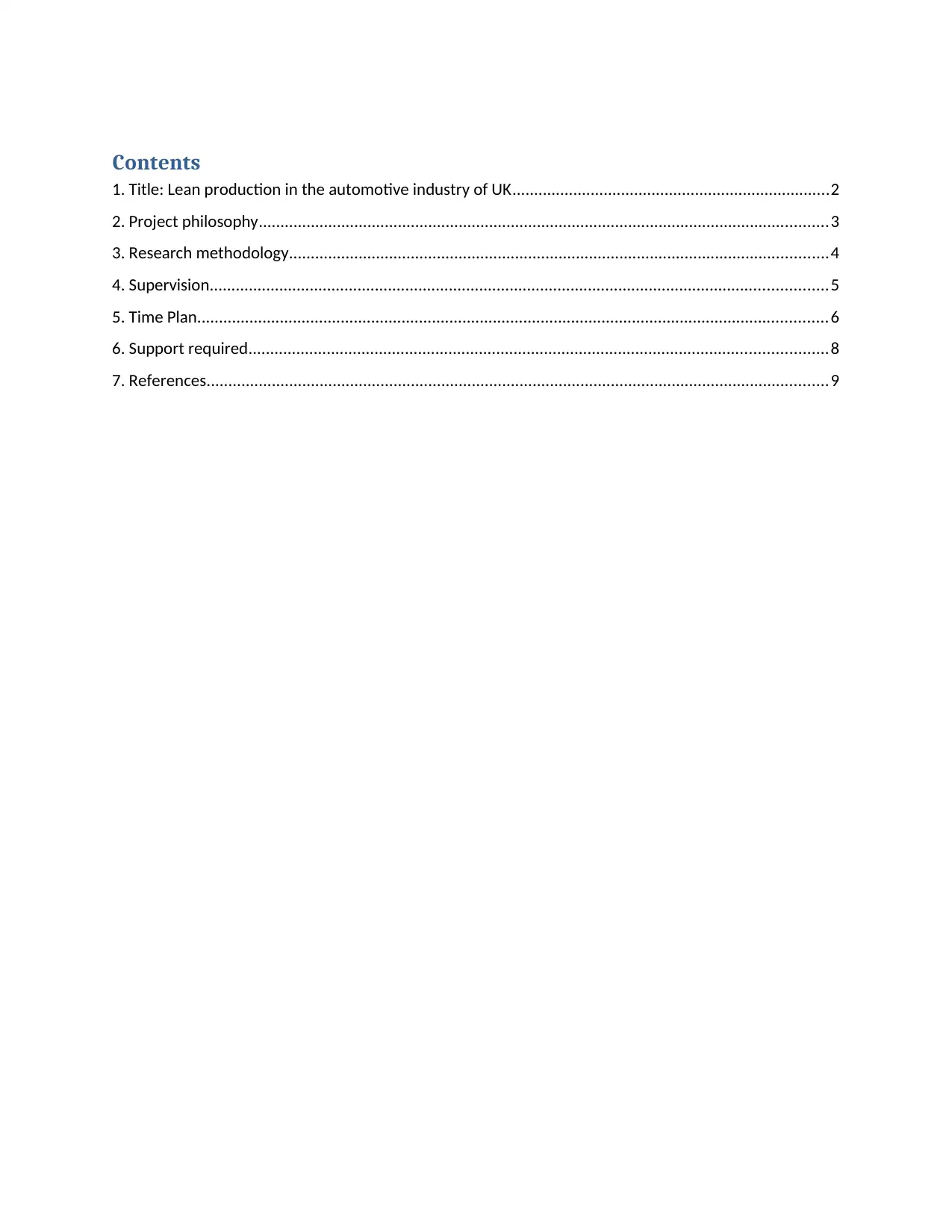
Contents
1. Title: Lean production in the automotive industry of UK.........................................................................2
2. Project philosophy...................................................................................................................................3
3. Research methodology............................................................................................................................4
4. Supervision..............................................................................................................................................5
5. Time Plan.................................................................................................................................................6
6. Support required.....................................................................................................................................8
7. References...............................................................................................................................................9
1. Title: Lean production in the automotive industry of UK.........................................................................2
2. Project philosophy...................................................................................................................................3
3. Research methodology............................................................................................................................4
4. Supervision..............................................................................................................................................5
5. Time Plan.................................................................................................................................................6
6. Support required.....................................................................................................................................8
7. References...............................................................................................................................................9
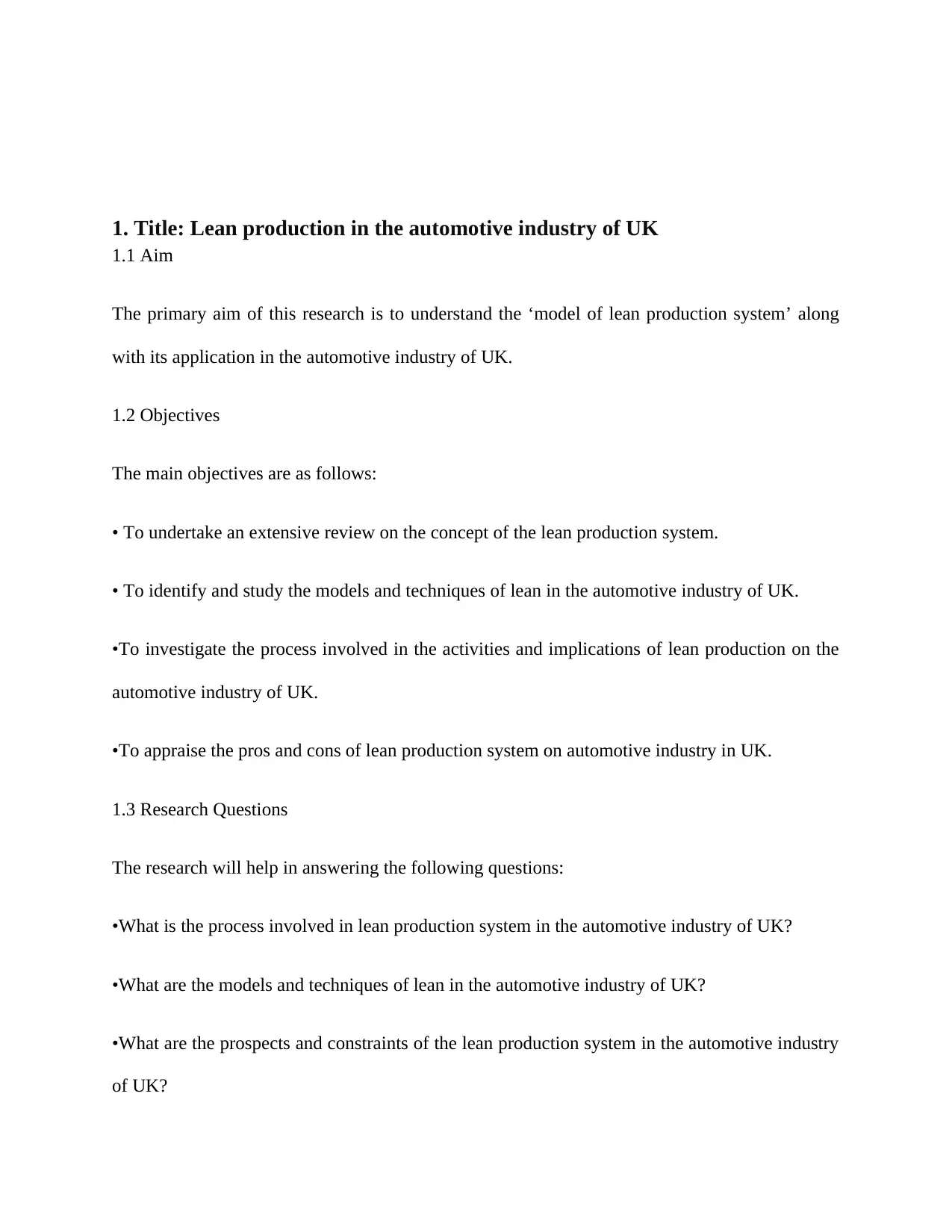
1. Title: Lean production in the automotive industry of UK
1.1 Aim
The primary aim of this research is to understand the ‘model of lean production system’ along
with its application in the automotive industry of UK.
1.2 Objectives
The main objectives are as follows:
• To undertake an extensive review on the concept of the lean production system.
• To identify and study the models and techniques of lean in the automotive industry of UK.
•To investigate the process involved in the activities and implications of lean production on the
automotive industry of UK.
•To appraise the pros and cons of lean production system on automotive industry in UK.
1.3 Research Questions
The research will help in answering the following questions:
•What is the process involved in lean production system in the automotive industry of UK?
•What are the models and techniques of lean in the automotive industry of UK?
•What are the prospects and constraints of the lean production system in the automotive industry
of UK?
1.1 Aim
The primary aim of this research is to understand the ‘model of lean production system’ along
with its application in the automotive industry of UK.
1.2 Objectives
The main objectives are as follows:
• To undertake an extensive review on the concept of the lean production system.
• To identify and study the models and techniques of lean in the automotive industry of UK.
•To investigate the process involved in the activities and implications of lean production on the
automotive industry of UK.
•To appraise the pros and cons of lean production system on automotive industry in UK.
1.3 Research Questions
The research will help in answering the following questions:
•What is the process involved in lean production system in the automotive industry of UK?
•What are the models and techniques of lean in the automotive industry of UK?
•What are the prospects and constraints of the lean production system in the automotive industry
of UK?
⊘ This is a preview!⊘
Do you want full access?
Subscribe today to unlock all pages.

Trusted by 1+ million students worldwide
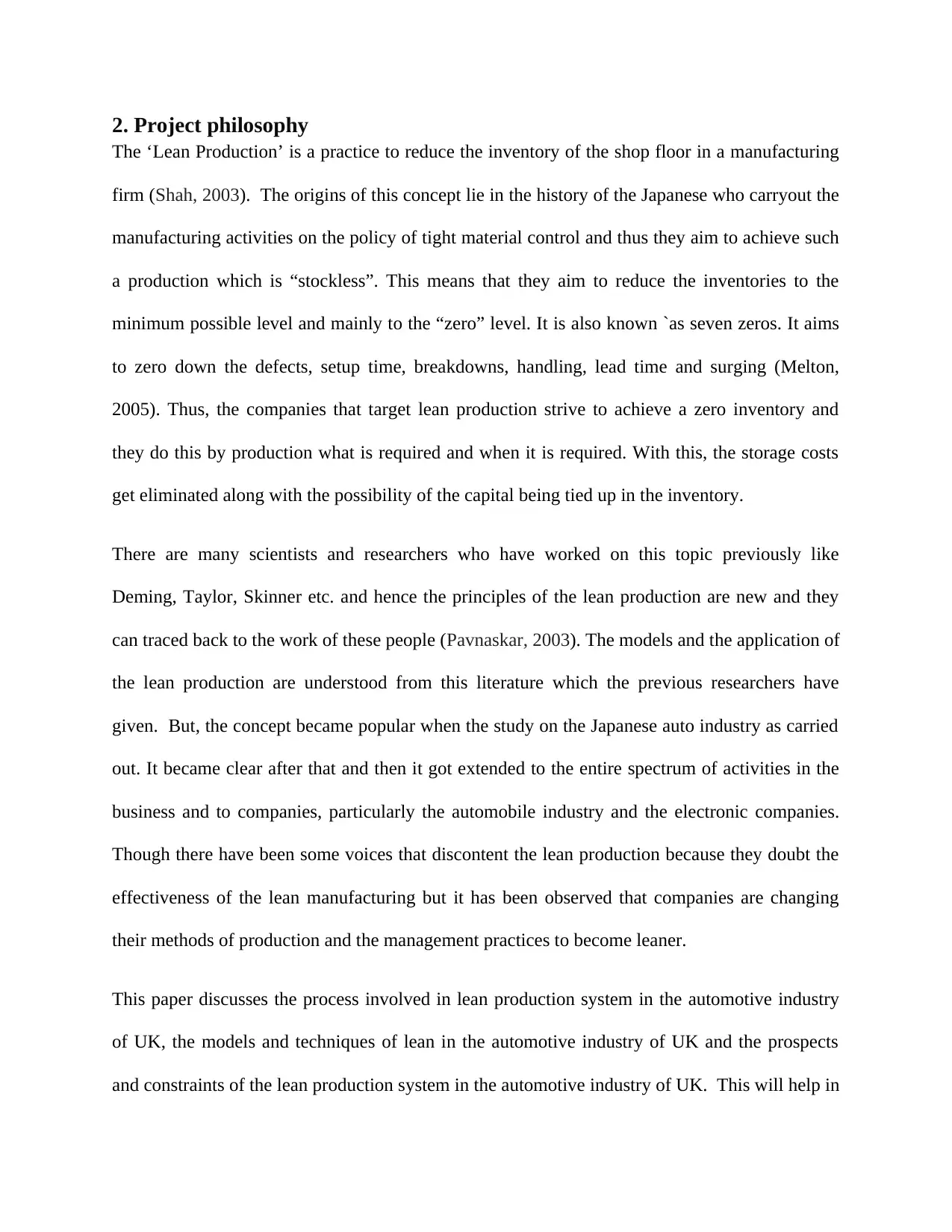
2. Project philosophy
The ‘Lean Production’ is a practice to reduce the inventory of the shop floor in a manufacturing
firm (Shah, 2003). The origins of this concept lie in the history of the Japanese who carryout the
manufacturing activities on the policy of tight material control and thus they aim to achieve such
a production which is “stockless”. This means that they aim to reduce the inventories to the
minimum possible level and mainly to the “zero” level. It is also known `as seven zeros. It aims
to zero down the defects, setup time, breakdowns, handling, lead time and surging (Melton,
2005). Thus, the companies that target lean production strive to achieve a zero inventory and
they do this by production what is required and when it is required. With this, the storage costs
get eliminated along with the possibility of the capital being tied up in the inventory.
There are many scientists and researchers who have worked on this topic previously like
Deming, Taylor, Skinner etc. and hence the principles of the lean production are new and they
can traced back to the work of these people (Pavnaskar, 2003). The models and the application of
the lean production are understood from this literature which the previous researchers have
given. But, the concept became popular when the study on the Japanese auto industry as carried
out. It became clear after that and then it got extended to the entire spectrum of activities in the
business and to companies, particularly the automobile industry and the electronic companies.
Though there have been some voices that discontent the lean production because they doubt the
effectiveness of the lean manufacturing but it has been observed that companies are changing
their methods of production and the management practices to become leaner.
This paper discusses the process involved in lean production system in the automotive industry
of UK, the models and techniques of lean in the automotive industry of UK and the prospects
and constraints of the lean production system in the automotive industry of UK. This will help in
The ‘Lean Production’ is a practice to reduce the inventory of the shop floor in a manufacturing
firm (Shah, 2003). The origins of this concept lie in the history of the Japanese who carryout the
manufacturing activities on the policy of tight material control and thus they aim to achieve such
a production which is “stockless”. This means that they aim to reduce the inventories to the
minimum possible level and mainly to the “zero” level. It is also known `as seven zeros. It aims
to zero down the defects, setup time, breakdowns, handling, lead time and surging (Melton,
2005). Thus, the companies that target lean production strive to achieve a zero inventory and
they do this by production what is required and when it is required. With this, the storage costs
get eliminated along with the possibility of the capital being tied up in the inventory.
There are many scientists and researchers who have worked on this topic previously like
Deming, Taylor, Skinner etc. and hence the principles of the lean production are new and they
can traced back to the work of these people (Pavnaskar, 2003). The models and the application of
the lean production are understood from this literature which the previous researchers have
given. But, the concept became popular when the study on the Japanese auto industry as carried
out. It became clear after that and then it got extended to the entire spectrum of activities in the
business and to companies, particularly the automobile industry and the electronic companies.
Though there have been some voices that discontent the lean production because they doubt the
effectiveness of the lean manufacturing but it has been observed that companies are changing
their methods of production and the management practices to become leaner.
This paper discusses the process involved in lean production system in the automotive industry
of UK, the models and techniques of lean in the automotive industry of UK and the prospects
and constraints of the lean production system in the automotive industry of UK. This will help in
Paraphrase This Document
Need a fresh take? Get an instant paraphrase of this document with our AI Paraphraser
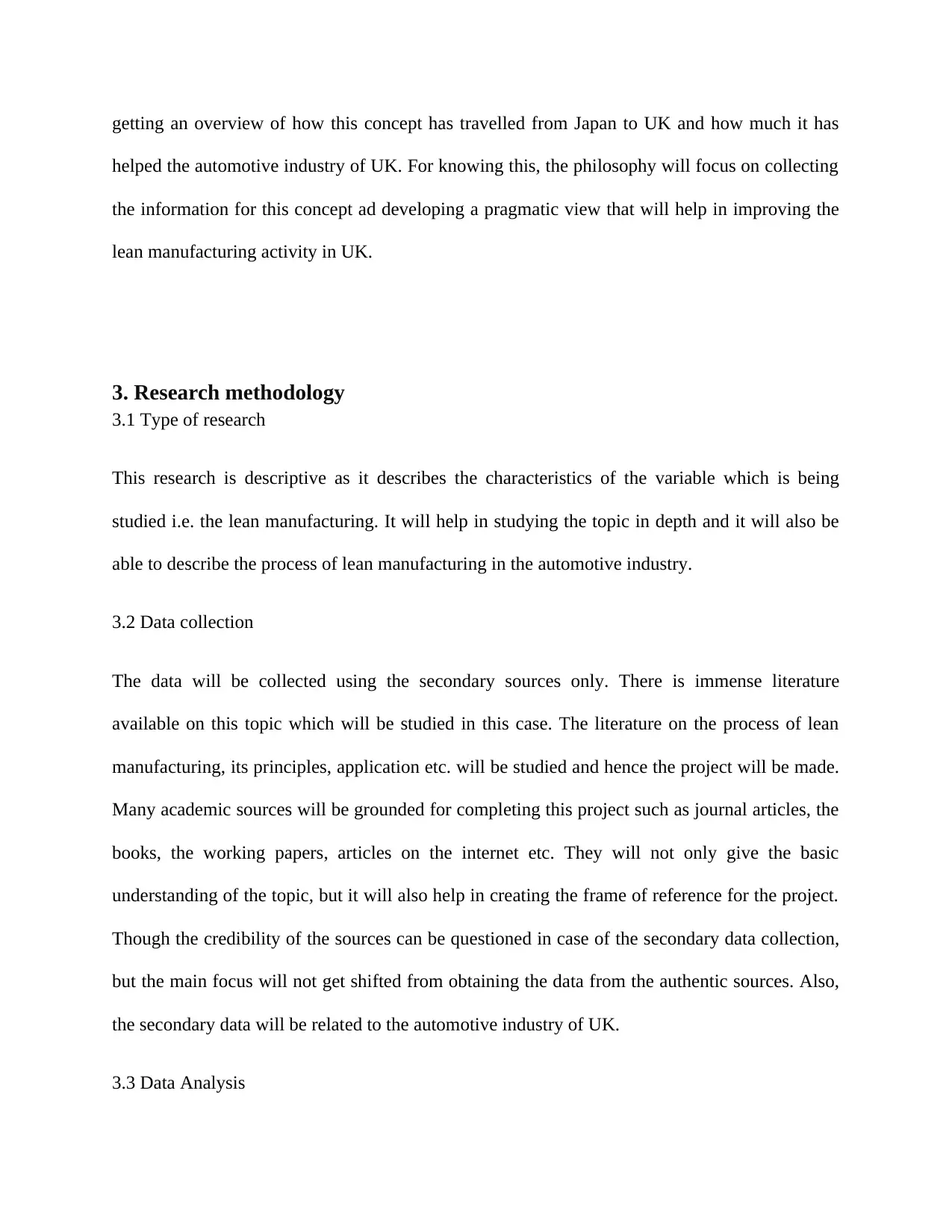
getting an overview of how this concept has travelled from Japan to UK and how much it has
helped the automotive industry of UK. For knowing this, the philosophy will focus on collecting
the information for this concept ad developing a pragmatic view that will help in improving the
lean manufacturing activity in UK.
3. Research methodology
3.1 Type of research
This research is descriptive as it describes the characteristics of the variable which is being
studied i.e. the lean manufacturing. It will help in studying the topic in depth and it will also be
able to describe the process of lean manufacturing in the automotive industry.
3.2 Data collection
The data will be collected using the secondary sources only. There is immense literature
available on this topic which will be studied in this case. The literature on the process of lean
manufacturing, its principles, application etc. will be studied and hence the project will be made.
Many academic sources will be grounded for completing this project such as journal articles, the
books, the working papers, articles on the internet etc. They will not only give the basic
understanding of the topic, but it will also help in creating the frame of reference for the project.
Though the credibility of the sources can be questioned in case of the secondary data collection,
but the main focus will not get shifted from obtaining the data from the authentic sources. Also,
the secondary data will be related to the automotive industry of UK.
3.3 Data Analysis
helped the automotive industry of UK. For knowing this, the philosophy will focus on collecting
the information for this concept ad developing a pragmatic view that will help in improving the
lean manufacturing activity in UK.
3. Research methodology
3.1 Type of research
This research is descriptive as it describes the characteristics of the variable which is being
studied i.e. the lean manufacturing. It will help in studying the topic in depth and it will also be
able to describe the process of lean manufacturing in the automotive industry.
3.2 Data collection
The data will be collected using the secondary sources only. There is immense literature
available on this topic which will be studied in this case. The literature on the process of lean
manufacturing, its principles, application etc. will be studied and hence the project will be made.
Many academic sources will be grounded for completing this project such as journal articles, the
books, the working papers, articles on the internet etc. They will not only give the basic
understanding of the topic, but it will also help in creating the frame of reference for the project.
Though the credibility of the sources can be questioned in case of the secondary data collection,
but the main focus will not get shifted from obtaining the data from the authentic sources. Also,
the secondary data will be related to the automotive industry of UK.
3.3 Data Analysis
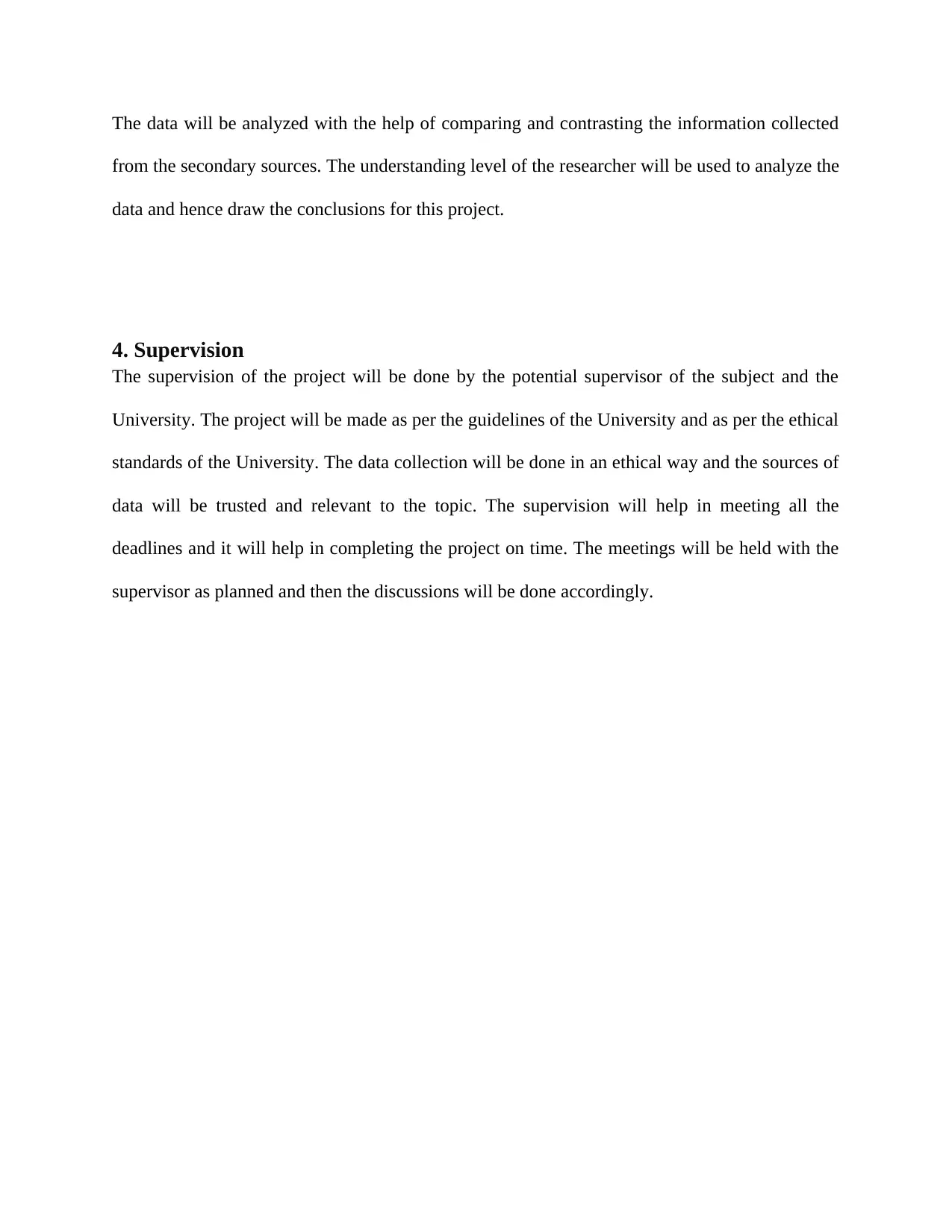
The data will be analyzed with the help of comparing and contrasting the information collected
from the secondary sources. The understanding level of the researcher will be used to analyze the
data and hence draw the conclusions for this project.
4. Supervision
The supervision of the project will be done by the potential supervisor of the subject and the
University. The project will be made as per the guidelines of the University and as per the ethical
standards of the University. The data collection will be done in an ethical way and the sources of
data will be trusted and relevant to the topic. The supervision will help in meeting all the
deadlines and it will help in completing the project on time. The meetings will be held with the
supervisor as planned and then the discussions will be done accordingly.
from the secondary sources. The understanding level of the researcher will be used to analyze the
data and hence draw the conclusions for this project.
4. Supervision
The supervision of the project will be done by the potential supervisor of the subject and the
University. The project will be made as per the guidelines of the University and as per the ethical
standards of the University. The data collection will be done in an ethical way and the sources of
data will be trusted and relevant to the topic. The supervision will help in meeting all the
deadlines and it will help in completing the project on time. The meetings will be held with the
supervisor as planned and then the discussions will be done accordingly.
⊘ This is a preview!⊘
Do you want full access?
Subscribe today to unlock all pages.

Trusted by 1+ million students worldwide
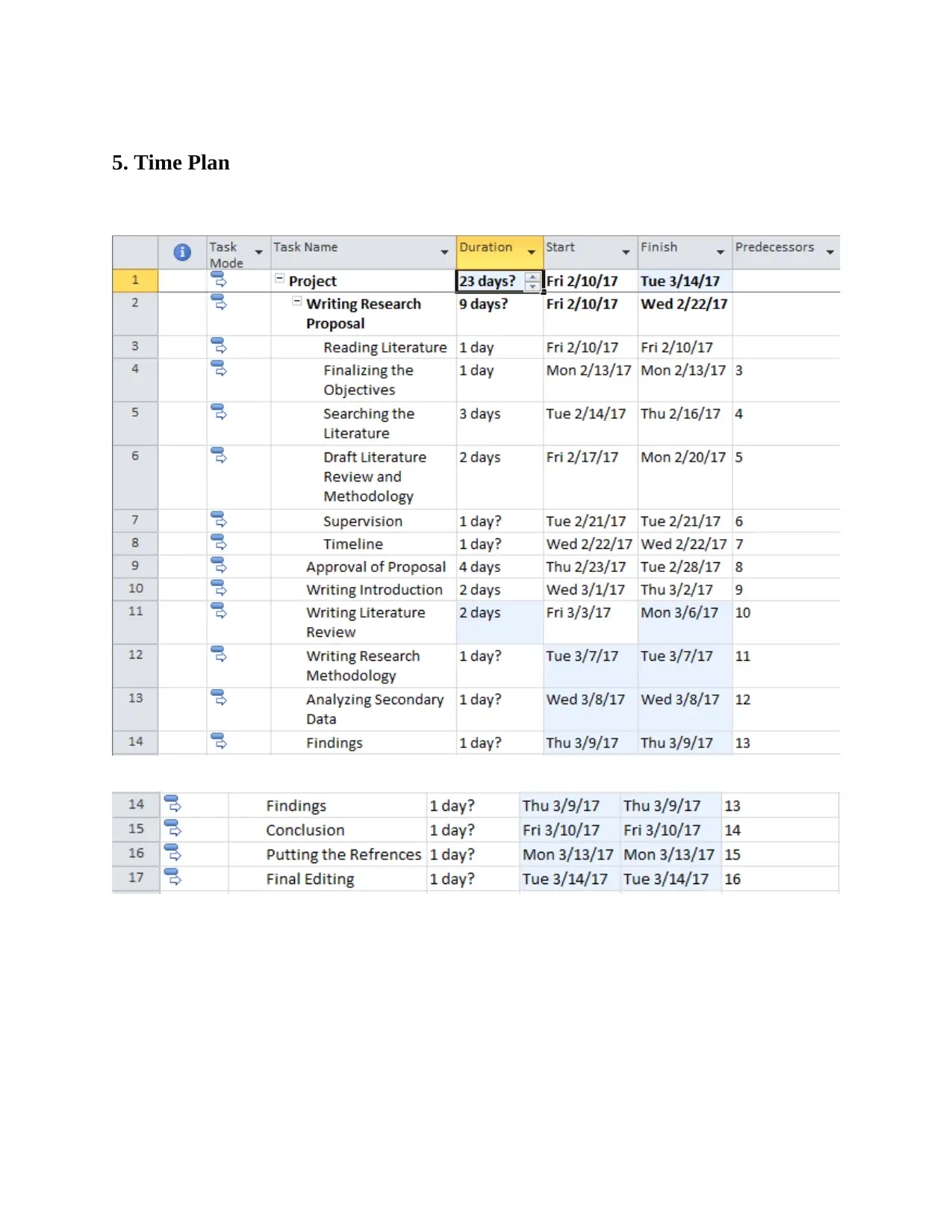
5. Time Plan
Paraphrase This Document
Need a fresh take? Get an instant paraphrase of this document with our AI Paraphraser
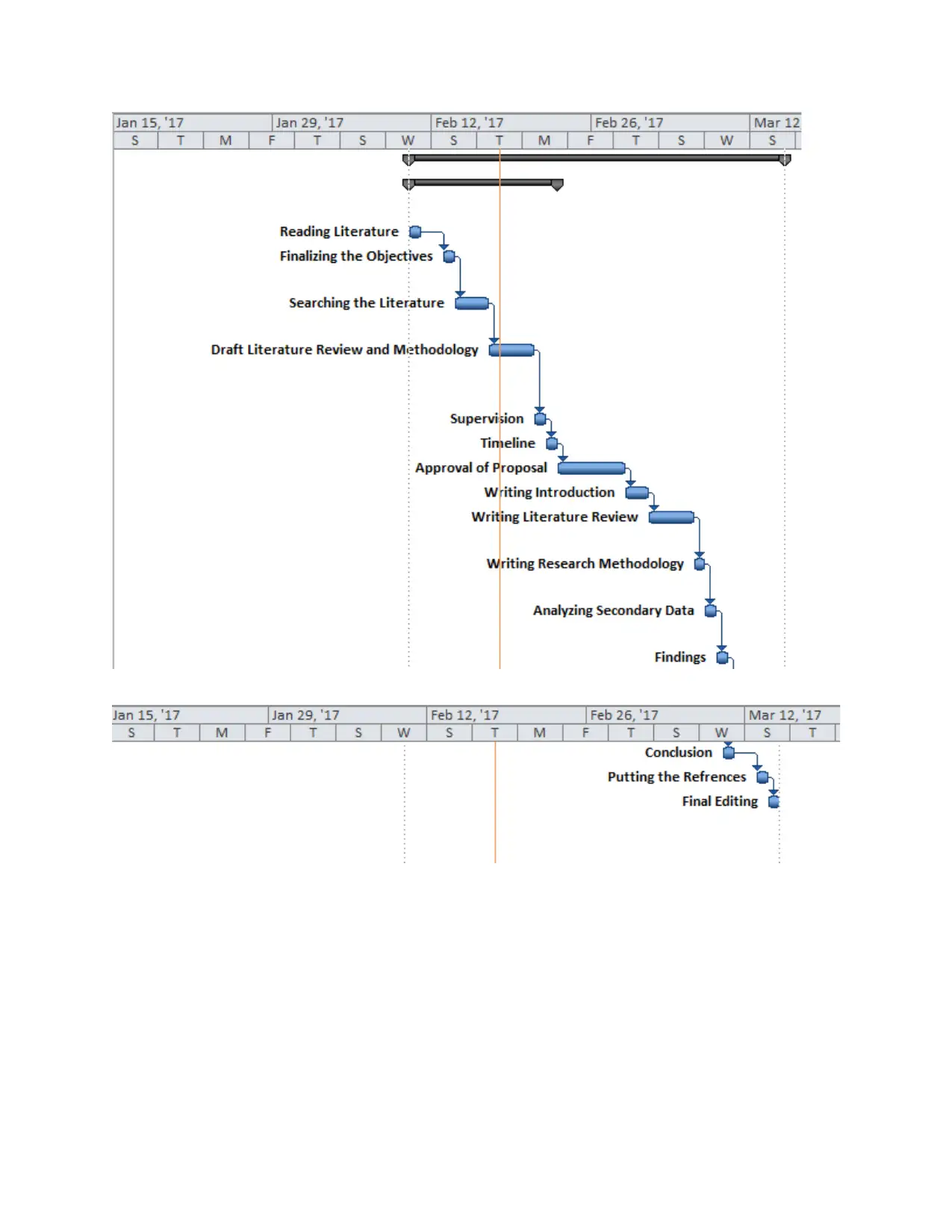
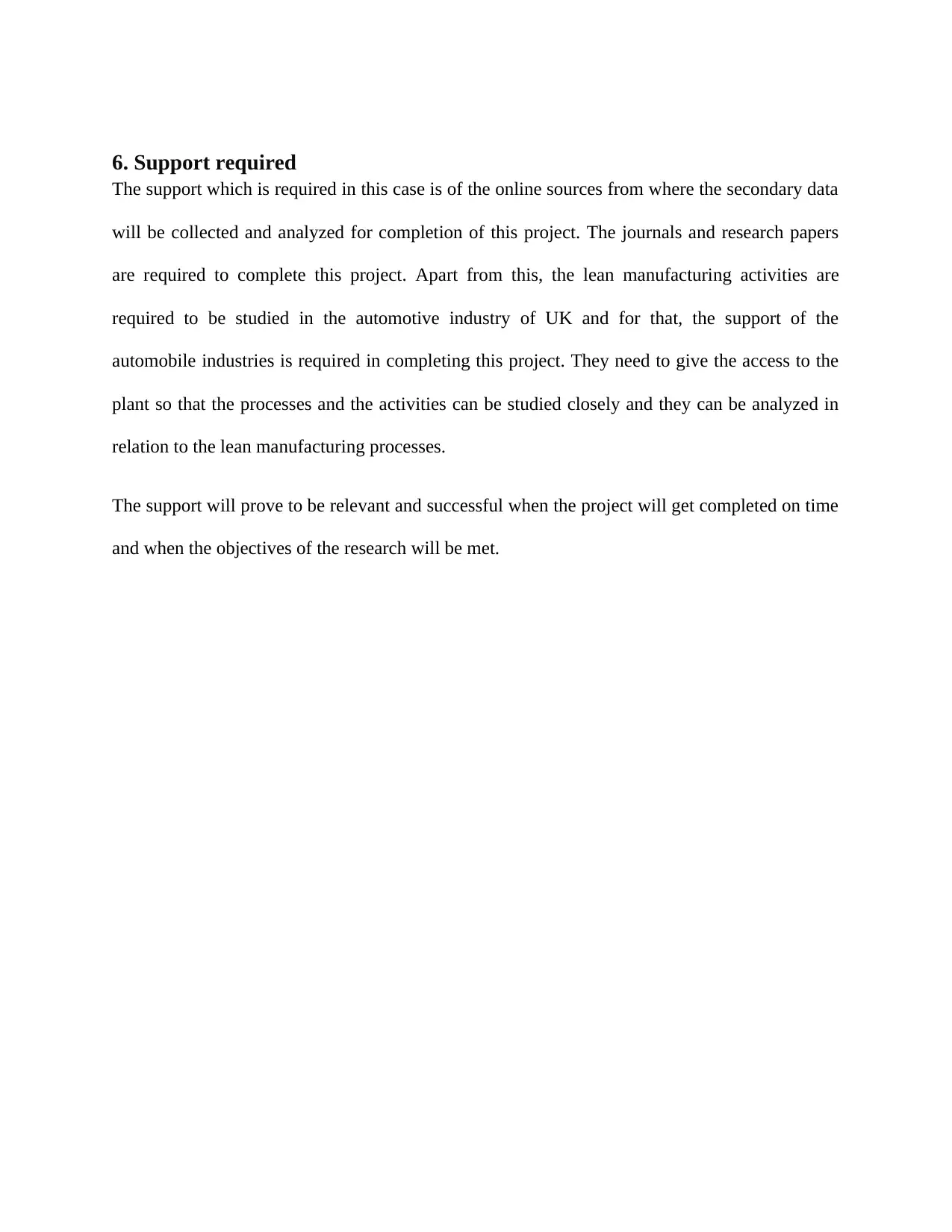
6. Support required
The support which is required in this case is of the online sources from where the secondary data
will be collected and analyzed for completion of this project. The journals and research papers
are required to complete this project. Apart from this, the lean manufacturing activities are
required to be studied in the automotive industry of UK and for that, the support of the
automobile industries is required in completing this project. They need to give the access to the
plant so that the processes and the activities can be studied closely and they can be analyzed in
relation to the lean manufacturing processes.
The support will prove to be relevant and successful when the project will get completed on time
and when the objectives of the research will be met.
The support which is required in this case is of the online sources from where the secondary data
will be collected and analyzed for completion of this project. The journals and research papers
are required to complete this project. Apart from this, the lean manufacturing activities are
required to be studied in the automotive industry of UK and for that, the support of the
automobile industries is required in completing this project. They need to give the access to the
plant so that the processes and the activities can be studied closely and they can be analyzed in
relation to the lean manufacturing processes.
The support will prove to be relevant and successful when the project will get completed on time
and when the objectives of the research will be met.
⊘ This is a preview!⊘
Do you want full access?
Subscribe today to unlock all pages.

Trusted by 1+ million students worldwide
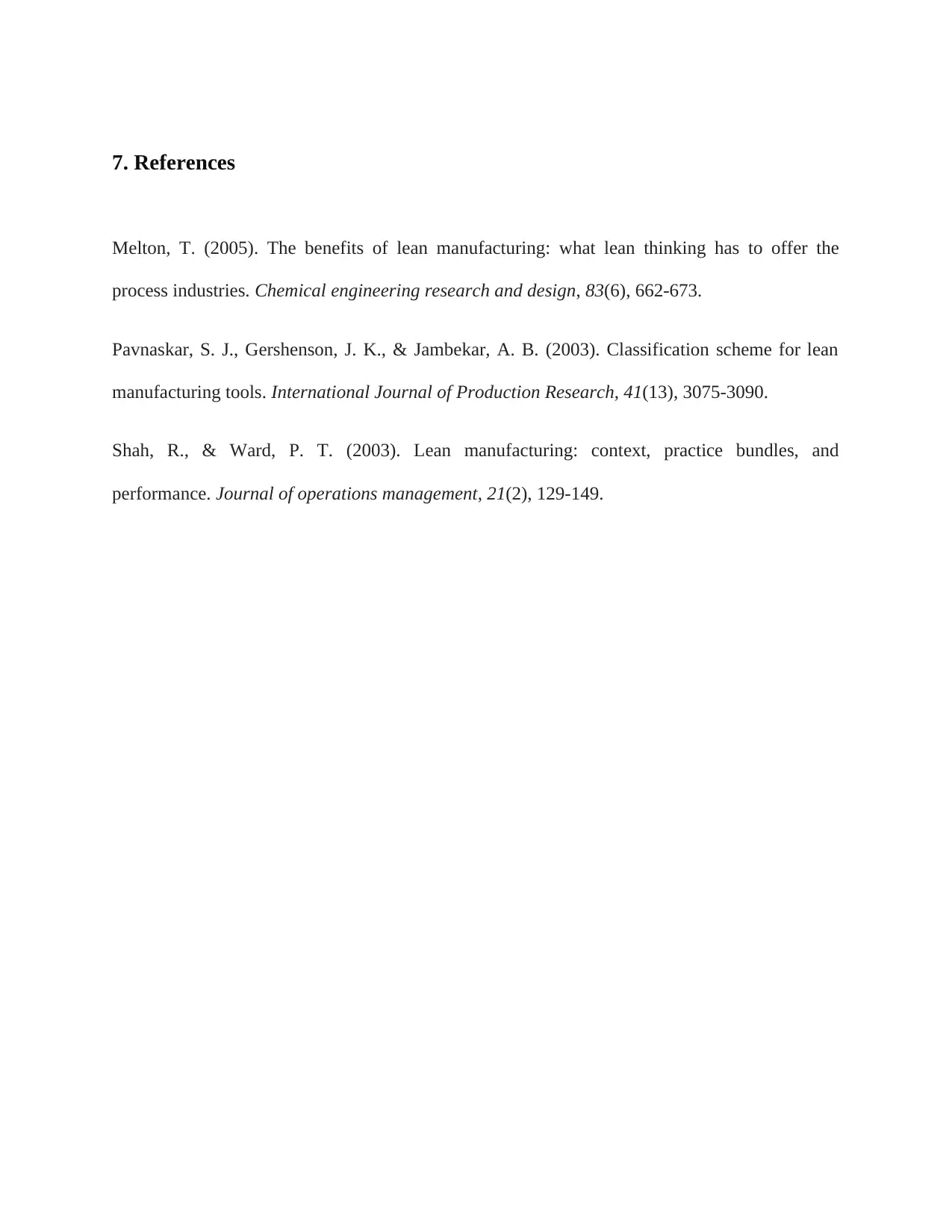
7. References
Melton, T. (2005). The benefits of lean manufacturing: what lean thinking has to offer the
process industries. Chemical engineering research and design, 83(6), 662-673.
Pavnaskar, S. J., Gershenson, J. K., & Jambekar, A. B. (2003). Classification scheme for lean
manufacturing tools. International Journal of Production Research, 41(13), 3075-3090.
Shah, R., & Ward, P. T. (2003). Lean manufacturing: context, practice bundles, and
performance. Journal of operations management, 21(2), 129-149.
Melton, T. (2005). The benefits of lean manufacturing: what lean thinking has to offer the
process industries. Chemical engineering research and design, 83(6), 662-673.
Pavnaskar, S. J., Gershenson, J. K., & Jambekar, A. B. (2003). Classification scheme for lean
manufacturing tools. International Journal of Production Research, 41(13), 3075-3090.
Shah, R., & Ward, P. T. (2003). Lean manufacturing: context, practice bundles, and
performance. Journal of operations management, 21(2), 129-149.
1 out of 10
Related Documents
Your All-in-One AI-Powered Toolkit for Academic Success.
+13062052269
info@desklib.com
Available 24*7 on WhatsApp / Email
![[object Object]](/_next/static/media/star-bottom.7253800d.svg)
Unlock your academic potential
Copyright © 2020–2025 A2Z Services. All Rights Reserved. Developed and managed by ZUCOL.





